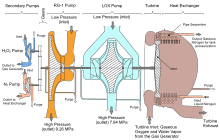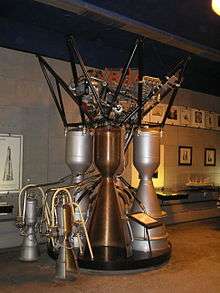RD-107
|
Rocket engine RD-107 "Vostok" in the Museum of Space and Missile Technology (Saint Petersburg). | |
| Country of origin |
|
|---|---|
| Designer | OKB-456 |
| Manufacturer | JSC Kuznetsov[1] |
| Application | booster engine |
| Associated L/V | R-7 Family of launchers |
| Predecessor | RD-105 |
| Status | In Production |
| Liquid-fuel engine | |
| Propellant | LOX / Kerosene |
| Cycle | Gas generator |
| Performance | |
| Thrust (vac.) |
RD-107: 1,000 kN (220,000 lbf) RD-107A: 1,020 kN (230,000 lbf) |
| Thrust (SL) |
RD-107: 810 kN (180,000 lbf) RD-107A: 839 kN (189,000 lbf) |
| Isp (vac.) |
RD-107: 313 sec RD-107A: 320.2 sec |
| Isp (SL) |
RD-107: 256 sec RD-107A: 263.3 sec |
| Dimensions | |
| Dry weight |
RD-107: 1,190 kg (2,620 lb) RD-107A1,190 kg (2,620 lb) |
| Used in | |
| First stage boosters for R-7 family | |
| References | |
| References | [2][3][4][5][5][6] |
The RD-107 and its sibling, the RD-108, are a type of rocket engine initially used to launch R-7 Semyorka missiles. RD-107 engines were later used on space launch vehicles based on the R-7. As of 2015, very similar RD-107A and RD-108A engines are used to launch the Soyuz FG, Soyuz-2.1a and Soyuz-2.1b, which are in active service.[7]
Design

The RD-107 was designed under the direction of Valentin Glushko at the Gas Dynamics Laboratory-Experimental Design Bureau (OKB-456) between 1954 and 1957. It uses liquid oxygen and kerosene as propellants, operating in a gas generator cycle. As was typical by all the descendants of the V-2 rocket technology, the turbine is driven by steam generated by catalytic decomposition of H2O2. The steam generator uses solid F-30-P-G catalyst. These are based on variable sized pellet covered in an aqueous solution of potassium permanganate and sodium as active catalyst. Each engine uses four fixed main combustion chambers. The RD-107 has an additional two vernier combustion chambers that can gimbal in a single plane, to supply thrust vectoring. The RD-108 has four of such vernier combustion chambers to supply full vector control to the Blok-A stage. The single-axle turbopump unit includes the steam driven turbine, an oxidizer pump, a fuel pump, and a nitrogen gas generator for tank pressurization.[3]
One important innovation of this engine was the capability to use variable mixture ratio between fuel and oxidizer. The natural variations in manufacturing between each engine meant that without an active propellant consumption control, each boosters would deplete oxygen and fuel at different rates. This might result in as much as tens of tonnes of propellant near the end of their burn. It would generate enormous strains on the structure and control authority due to the mass imbalance. Thus, the engines and the control system was developed to ensure the simultaneous consumption of propellant mass among the four R-7 boosters.[3][8]
Production
The RD-107 and RD-108 engines are produced at the JSC Kuznetsov plant in Samara, Russia, under the supervision of the Privolzhskiy branch of NPO Energomash, also known as the Volga branch.[1][3][5] The Privolzhsky branch was organized as a branch of OKB-456 in 1958, specifically for the manufacture of RD-107 and RD-108 engines. The branch was led by Y.D. Solovjev until 1960, then by R.I. Zelenev until 1975, then by A.F. Udalov until 1978, and is currently led by A.A. Ganin.[9]
Versions
Modifications to the RD-107 design have led to production of several distinct versions of the engine:
- RD-107 (AKA 8D74): Original version.[4] Used on the R-7, Sputnik, Vostok and Voskhod.[3]
- RD-107K (AKA 8D74K): Improved version of the 8D74. Used on the Molniya (8К78).[3]
- RD-107ММ (AKA 8D728 or 8D74M): Increased thrust over the 8D74K by 5%.[4] Used on the Molniya-M (8К78М) and Soyuz (11A511).[3]
- RD-117 (AKA 11D511): Improved structural changes.[4] Used on the Soyuz-U (11А511U) and Soyuz-U2 (11A511U2).[3]
- RD-107А (AKA 14D22): Improved version of the 11D511 with new injector design that eliminated the high frequency combustion instabilities.[4] Used on the Soyuz-FG (11А511U-FG), Soyuz-STA (372RN21A) and Soyuz-STB (372RN21B).[3]
- RD-107А (AKA 14D22 kHz): Chemical ignited version of the 14D22. Used on the Soyuz-2.1a (14A14-1A) and Soyuz-2.1b (14A14-1B).[3][10]
| Engine | RD-107 | RD-107K | RD-107ММ | RD-117 | RD-107A | RD-107A |
|---|---|---|---|---|---|---|
| AKA | 8D74 | 8D74K | 8D728 or 8D74M | 11D511 | 14D22 | 14D22KhZ |
| Development | 1954-1959 | 1965-1976 | 1969-1975 | 1993-2001 | 2001-2004 | |
| Engine Cycle | Liquid propellant rocket engine burning RG-1/LOX in the gas generator cycle with the turbine driven by steam generated by catalytic decomposition of H2O2 | |||||
| Combustion Chamber Pressure | 5.88 MPa (853 psi) | 5.88 MPa (853 psi) | 5.85 MPa (848 psi) | 5.32 MPa (772 psi) | 6.00 MPa (870 psi) | 6.00 MPa (870 psi) |
| Thrust (Sea Level) | 813.98 kN (182,990 lbf) | 818.88 kN (184,090 lbf) | 755.14 kN (169,760 lbf) | 778.68 kN (175,050 lbf) | 839.48 kN (188,720 lbf) | 839.48 kN (188,720 lbf) |
| Thrust (Vacuum) | 1,000.31 kN (224,880 lbf) | 995.41 kN (223,780 lbf) | 921.86 kN (207,240 lbf) | Unknown | 1,019.93 kN (229,290 lbf) | 1,019.93 kN (229,290 lbf) |
| Specific Impulse (Sea Level) | 256 s (2.51 km/s) | 256.2 s (2.512 km/s) | 257 s (2.52 km/s) | 253 s (2.48 km/s) | 263.3 s (2.582 km/s) | 263.3 s (2.582 km/s) |
| Specific Impulse (Vacuum) | 313 s (3.07 km/s) | 313.3 s (3.072 km/s) | 314 s (3.08 km/s) | 316 s (3.10 km/s) | 320.2 s (3.140 km/s) | 320.2 s (3.140 km/s) |
| Height | 2,865 mm (112.8 in) | 2,865 mm (112.8 in) | 2,865 mm (112.8 in) | 2,865 mm (112.8 in) | 2,578 mm (101.5 in) | 2,578 mm (101.5 in) |
| Diameter | 1,850 mm (73 in) | 1,850 mm (73 in) | 1,850 mm (73 in) | 1,850 mm (73 in) | 1,850 mm (73 in) | 1,850 mm (73 in) |
| Intended Use | R-7, Sputnik, Vostok and Voskhod | Molniya (8К78) | Molniya-M (8К78М) and Soyuz (11A511) | Soyuz-U (11А511U) and Soyuz-U2 (11A511U2) | Soyuz-FG (11А511U-FG), Soyuz-STA (372RN21A) and Soyuz-STB (372RN21B) | Soyuz-2.1a (14A14-1A) and Soyuz-2.1b (14A14-1B) |
| Status | Retired | Retired | Retired | In Production | In Production | In Production |
| References | Unless otherwise noted:[3][4] | |||||
Similar modifications have led to several distinct versions of the RD-108:
- RD-108 (AKA 8D75): Original version.[4] Used on the R-7, Sputnik, Vostok and Voskhod.[3]
- RD-108K (AKA 8D75K): Improved version of the 8D74. Used on the Molniya (8К78).[3]
- RD-108ММ (AKA 8D727 or 8D75M): Increased thrust over the 8D74K by 5%.[4] Used on the Molniya-M (8К78М) and Soyuz (11A511).[3]
- RD-118 (AKA 11D512): Improved structural changes.[4] Used on the Soyuz-U (11А511U).[3]
- RD-118PF (AKA 11D512PF): Version of the 11D5212 that run on Syntin rather than RG-1. It used selected injectors to minimize instabilities without changing constructions methods. But it required significant amount of engines production to get injectors that complied with the stringent specifications. Used on the Soyuz-U2 (11A511U2).[3][11]
- RD-108А (AKA 14D21): Improved version of the 11D511 with new injector design that eliminated the high frequency combustion instabilities.[4] Used on the Soyuz-FG (11А511U-FG), Soyuz-STA (372RN21A) and Soyuz-STB (372RN21B).[3]
- RD-108А (AKA 14D21 kHz): Chemical ignited version of the 14D22. Used on the Soyuz-2.1a (14A14-1A) and Soyuz-2.1b (14A14-1B).[3][10]
| Engine | RD-108 | RD-108K | RD-108ММ | RD-118 | RD-118PF | RD-108A | RD-108A |
|---|---|---|---|---|---|---|---|
| AKA | 8D75 | 8D75K | 8D727 or 8D75M | 11D512 | 11D512PF[11] | 14D21 | 14D21KhZ |
| Development | 1954-1959 | 1965-1976 | 1969-1975 | 1979-1981 | 1993-2001 | 2001-2004 | |
| Engine Cycle | Liquid propellant rocket engine burning RG-1/LOX in the gas generator cycle with the turbine driven by steam generated by catalytic decomposition of H2O2 | ||||||
| Propellant | RG-1/LOX | Syntin/LOX[11] | RG-1/LOX | ||||
| Combustion Chamber Pressure | 5.10 MPa (740 psi) | 5.10 MPa (740 psi) | 5.32 MPa (772 psi) | 5.85 MPa (848 psi) | 5.39 MPa (782 psi) | 5.44 MPa (789 psi) | 5.44 MPa (789 psi) |
| Thrust (Sea Level) | 745.33 kN (167,560 lbf) | 745.33 kN (167,560 lbf) | 676.68 kN (152,120 lbf) | 818.88 kN (184,090 lbf) | Unknown | 792.41 kN (178,140 lbf) | 792.41 kN (178,140 lbf) |
| Thrust (Vacuum) | 941.47 kN (211,650 lbf) | 941.47 kN (211,650 lbf) | 833.60 kN (187,400 lbf) | 1,000.31 kN (224,880 lbf) | Unknown | 921.86 kN (207,240 lbf) | 921.86 kN (207,240 lbf) |
| Specific Impulse (Sea Level) | 248 s (2.43 km/s) | 248.2 s (2.434 km/s) | 253 s (2.48 km/s) | 257 s (2.52 km/s) | 263.5 s (2.584 km/s) | 257.7 s (2.527 km/s) | 257.7 s (2.527 km/s) |
| Specific Impulse (Vacuum) | 315 s (3.09 km/s) | 314.2 s (3.081 km/s) | 316 s (3.10 km/s) | 314 s (3.08 km/s) | Unknown | 320.6 s (3.144 km/s) | 320.6 s (3.144 km/s) |
| Height | 2,865 mm (112.8 in) | 2,865 mm (112.8 in) | 2,865 mm (112.8 in) | 2,865 mm (112.8 in) | 2,865 mm (112.8 in) | 2,865 mm (112.8 in) | 2,865 mm (112.8 in) |
| Diameter | 1,950 mm (77 in) | 1,950 mm (77 in) | 1,950 mm (77 in) | 1,950 mm (77 in) | 1,950 mm (77 in) | 1,950 mm (77 in) | 1,950 mm (77 in) |
| Intended Use | R-7, Sputnik, Vostok and Voskhod | Molniya (8К78) | Molniya-M (8К78М) and Soyuz (11A511) | Soyuz-U (11А511U) | Soyuz-U2 (11A511U2) | Soyuz-FG (11А511U-FG), Soyuz-STA (372RN21A) and Soyuz-STB (372RN21B) | Soyuz-2.1a (14A14-1A) and Soyuz-2.1b (14A14-1B) |
| Status | Retired | Retired | Retired | In Production | Retired | In Production | In Production |
| References | Unless otherwise noted:[3][4] | ||||||
Work on the 14D21 and 14D22 engines started in 1986, with a preliminary design completed in 1993. These engines incorporate a new injector head design to increase specific impulse. The first launch of a Progress cargo spacecraft using a launch vehicle equipped with these engines took place in May 2001. The first human spaceflight launch utilizing these engines took place in October 2002.[5]
Hypergolic vs. pyrotechnic ignition
Currently produced engines are ignited with a pyrotechnic ignition system. Energomash reports a new, hypergolic ignition system (on engines designated 14D21kHz and 14D22kHz) are ready for certification and flight tests.[5]
References
- 1 2 "RD-107, RD-108". JSC Kuznetsov. Retrieved 2015-07-17.
- ↑ "RD-107-8D74". Encyclopedia Astronautica. Retrieved 2015-07-14.
- 1 2 3 4 5 6 7 8 9 10 11 12 13 14 15 16 17 18 19 "ЖРД РД-107 и РД-108 и их модификации" [RD-107 and RD-108 and their modifications] (in Russian). Retrieved 2015-07-14.
- 1 2 3 4 5 6 7 8 9 10 11 "NPO Energomash list of engines". NPO Energomash. Retrieved 2015-06-20.
- 1 2 3 4 5 "RD-107/108". NPO Energomash. Retrieved 2015-07-14.
- ↑ John R. London III (October 1994). LEO on the Cheap (PDF). Air University Press. pp. 68–69. ISBN 0-89499-134-5. Archived from the original (PDF) on 2008-05-14.
- ↑ "Engines". NPO Energomash. Retrieved 2015-07-14.
- ↑ Chertok, Boris (June 2006). "Chapter 16 — The Seven Problems of the R-7 Missile". Rockets and People Vol. 2 — Creating a Rocket Industry (PDF). Volume 2 (NASA SP-2006-4110). NASA. p. 292. Retrieved 2015-07-15.
- ↑ "History". NPO Energomash. Retrieved 2015-07-14.
- 1 2 Zak, Anatoly. "Soyuz-2 launch vehicle (14A14)". RussianSpaceWeb. Retrieved 2015-07-14.
- 1 2 3 Pillet, Nicolas. "Le lanceur Soyouz-U2 (11A511U-2)" [The Soyuz-U2 Launcher (11A511U-2)] (in French). Kosmonavtika.com. Retrieved 2015-07-14.
External links
| Wikimedia Commons has media related to RD-107. |

